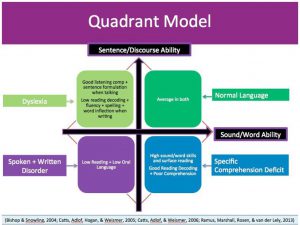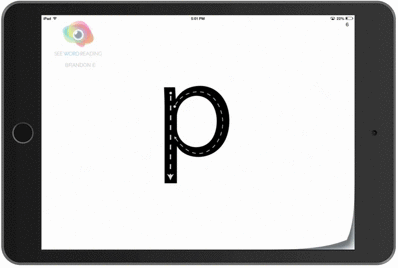Teaching Tips for Struggling Students

As technology increases and teachers take on a more personalized learning approach, it’s important to involve struggling students in the conversation. Our team is looking to Nickola Wolf Nelson for successful techniques when addressing children’s literacy challenges in today’s world. Dr. Nelson, Professor Emerita in the Department of Speech, Language, and Hearing Sciences and former Director of the Ph.D. program in Interdisciplinary Health Sciences at Western Michigan University, is sharing her tips for educating struggling students, specifically those with dyslexia – take a look:
1. First determine the unique challenge with the quadrant model
Not all reading problems are alike. Educators must first determine the student’s literacy challenge before determining how to help.
Nelson suggests using the four key profiles of the quadrant model to screen for literacy difficulties. The quadrant model displays levels of sound/word ability and sentence/discourse ability to determine skill level. For example, a student with dyslexia would be strong in sentence/discourse ability, but weaker in sound/word level ability, so when teaching these students educators should focus on the structure of words.

2. Use dyslexia identifiers
Nelson noted that while many students with dyslexia are good students and score well on tests, many still need an Individualized Education Program (IEP) and explicit instruction. Some states have introduced dyslexia legislation to offer appropriate instruction for struggling dyslexic students.
To identify dyslexia and other literacy disorders in students, parents and teachers can fill out the Student Language Scale (SLS) from the Test of Integrated Language & Literacy Skills(TILLS). Educators can then use some form of standardized testing, like TILLS, to understand students’ strengths and needs.
3. Embed explicit instruction into grade-level curricula
To help teach word structure knowledge, Dr. Nelson recommends educators embed explicit instruction into grade level curricula to develop all students’ reading decoding, spelling, and vocabulary skills.
4. Make it fun, make it multi-sensory
“My encouragement to teachers is to play, teach your kids to focus on the fun of making rhymes with words,” said Nelson. She noted that this can work with both younger and older grades.
Also, sound-symbol association skills can be built by using a multi- modal, multi-sensory, multi-linguistic approach to make association automatic. This kind of explicit instruction is especially effective for students with dyslexia.
5. Emphasize writing
Nelson emphasized using writing instruction as a great way to get classroom teachers and special service providers working in the same space. They can work together using regular curricular assignments as context for students with literacy challenges.
Educators can merge teaching of writing processes with language processes through planning and organizing ideas, drafting, revising, proofreading and editing, and presenting and celebrating their work.
Nelson shared even more valuable tips for teaching students with literacy challenges throughout the edWebinar, which can be viewed at the link below.
To read the full article or learn more expert teaching tips, visit eSchool News – Daily Tech News and Innovation.
Want a Step-by-Step Easy Path to Learn to Read?
See Words: School and See Words: Home uses the fundamental steps in 14 engaging lessons using proven multi-sensory methods and phonics.

Want a Step-by-Step Easy Path to Learn to Read?
See Words: School lays out the fundamental steps in 14 engaging lessons using proven multi-sensory methods and phonics. Download the suite of apps from the Apple App Store now.